Xingyuan Xu
Generative molecule evolution using 3D pharmacophore for efficient Structure-Based Drug Design
Jul 27, 2025Abstract:Recent advances in generative models, particularly diffusion and auto-regressive models, have revolutionized fields like computer vision and natural language processing. However, their application to structure-based drug design (SBDD) remains limited due to critical data constraints. To address the limitation of training data for models targeting SBDD tasks, we propose an evolutionary framework named MEVO, which bridges the gap between billion-scale small molecule dataset and the scarce protein-ligand complex dataset, and effectively increase the abundance of training data for generative SBDD models. MEVO is composed of three key components: a high-fidelity VQ-VAE for molecule representation in latent space, a diffusion model for pharmacophore-guided molecule generation, and a pocket-aware evolutionary strategy for molecule optimization with physics-based scoring function. This framework efficiently generate high-affinity binders for various protein targets, validated with predicted binding affinities using free energy perturbation (FEP) methods. In addition, we showcase the capability of MEVO in designing potent inhibitors to KRAS$^{\textrm{G12D}}$, a challenging target in cancer therapeutics, with similar affinity to the known highly active inhibitor evaluated by FEP calculations. With high versatility and generalizability, MEVO offers an effective and data-efficient model for various tasks in structure-based ligand design.
Data-Driven Parametrization of Molecular Mechanics Force Fields for Expansive Chemical Space Coverage
Aug 23, 2024



Abstract:A force field is a critical component in molecular dynamics simulations for computational drug discovery. It must achieve high accuracy within the constraints of molecular mechanics' (MM) limited functional forms, which offers high computational efficiency. With the rapid expansion of synthetically accessible chemical space, traditional look-up table approaches face significant challenges. In this study, we address this issue using a modern data-driven approach, developing ByteFF, an Amber-compatible force field for drug-like molecules. To create ByteFF, we generated an expansive and highly diverse molecular dataset at the B3LYP-D3(BJ)/DZVP level of theory. This dataset includes 2.4 million optimized molecular fragment geometries with analytical Hessian matrices, along with 3.2 million torsion profiles. We then trained an edge-augmented, symmetry-preserving molecular graph neural network (GNN) on this dataset, employing a carefully optimized training strategy. Our model predicts all bonded and non-bonded MM force field parameters for drug-like molecules simultaneously across a broad chemical space. ByteFF demonstrates state-of-the-art performance on various benchmark datasets, excelling in predicting relaxed geometries, torsional energy profiles, and conformational energies and forces. Its exceptional accuracy and expansive chemical space coverage make ByteFF a valuable tool for multiple stages of computational drug discovery.
Dual-polarization RF Channelizer Based on Kerr Soliton Microcomb Sources
Mar 14, 2024Abstract:We report a dual-polarization radio frequency (RF) channelizer based on microcombs. With the tailored mismatch between the FSRs of the active and passive MRRs, wideband RF spectra can be channelized into multiple segments featuring digital compatible bandwidths via the Vernier effect. Due to the use of dual polarization states, the number of channelized spectral segments, and thus the RF instantaneous bandwidth (with a certain spectral resolution), can be doubled. In our experiments, we used 20 microcomb lines with 49 GHz FSR to achieve 20 channels for each polarization, with high RF spectra slicing resolutions at 144 MHz (TE) and 163 MHz (TM), respectively; achieving an instantaneous RF operation bandwidth of 3.1 GHz (TE) and 2.2 GHz (TM). Our approach paves the path towards monolithically integrated photonic RF receivers (the key components active and passive MRRs are all fabricated on the same platform) with reduced complexity, size, and unprecedented performance, which is important for wide RF applications with digital compatible signal detection.
* 7 pages 4 figures, 82 references
Maximizing the performance for microcomb based microwave photonic transversal signal processors
Sep 10, 2023Abstract:Microwave photonic (MWP) transversal signal processors offer a compelling solution for realizing versatile high-speed information processing by combining the advantages of reconfigurable electrical digital signal processing and high-bandwidth photonic processing. With the capability of generating a number of discrete wavelengths from micro-scale resonators, optical microcombs are powerful multi-wavelength sources for implementing MWP transversal signal processors with significantly reduced size, power consumption, and complexity. By using microcomb-based MWP transversal signal processors, a diverse range of signal processing functions have been demonstrated recently. In this paper, we provide a detailed analysis for the processing inaccuracy that is induced by the imperfect response of experimental components. First, we investigate the errors arising from different sources including imperfections in the microcombs, the chirp of electro-optic modulators, chromatic dispersion of the dispersive module, shaping errors of the optical spectral shapers, and noise of the photodetector. Next, we provide a global picture quantifying the impact of different error sources on the overall system performance. Finally, we introduce feedback control to compensate the errors caused by experimental imperfections and achieve significantly improved accuracy. These results provide a guide for optimizing the accuracy of microcomb-based MWP transversal signal processors.
* 15 pages, 12 figures, 60 references
Phase retrieval of programmable photonic integrated circuits based on an on-chip fractional-delay reference path
Jul 29, 2022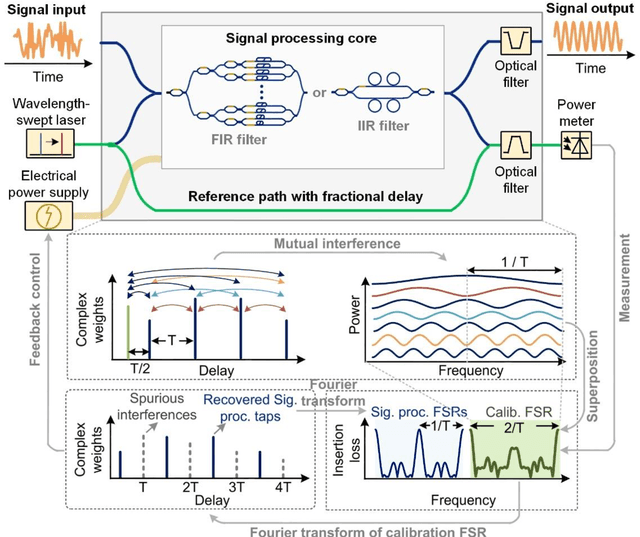
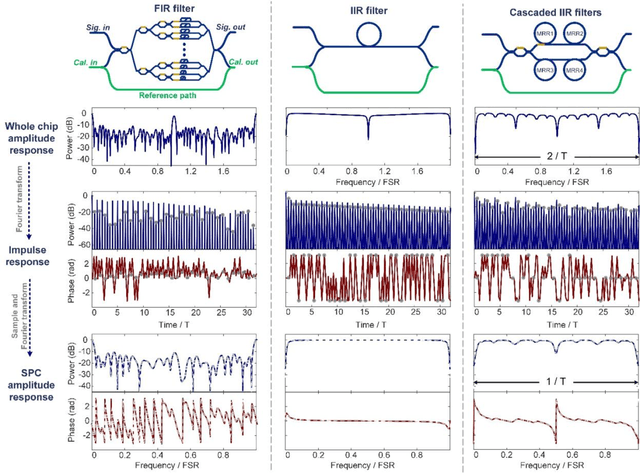
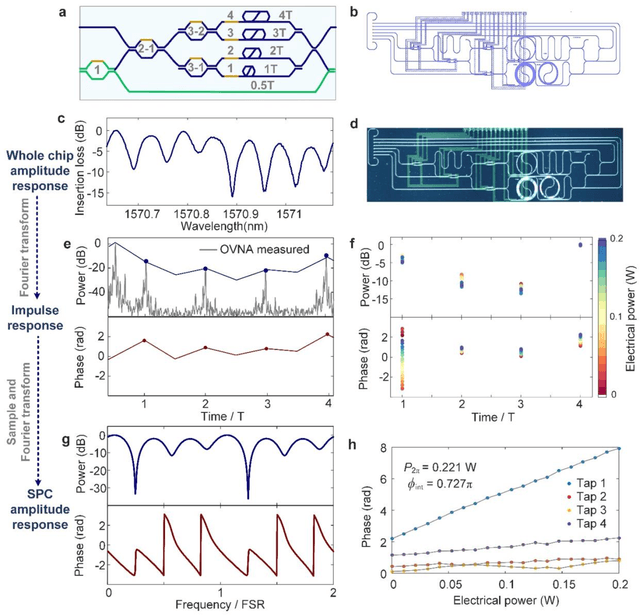
Abstract:Programmable photonic integrated circuits (PICs), offering diverse signal processing functions within a single chip, are promising solutions for applications ranging from optical communications to artificial intelligence. While the scale and complexity of programmable PICs is increasing, the characterization, and thus calibration, of them becomes increasingly challenging. Here we demonstrate a phase retrieval method for programmable PICs using an on-chip fractional-delay reference path. The impulse response of the chip can be uniquely and precisely identified from only the insertion loss using a standard complex Fourier transform. We demonstrate our approach experimentally with a 4-tap finite-impulse-response chip. The results match well with expectations and verifies our approach as effective for individually determining the taps' weights without the need for additional ports and photodiodes.
Optical Adaptive LMS Equalizer with an Opto-electronic Feedback Loop
Nov 09, 2021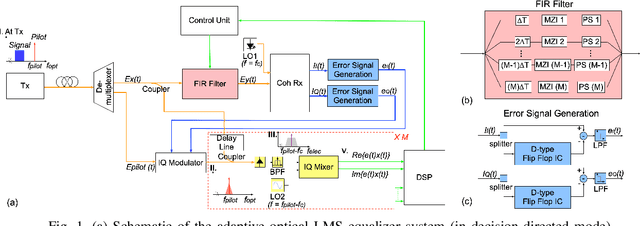
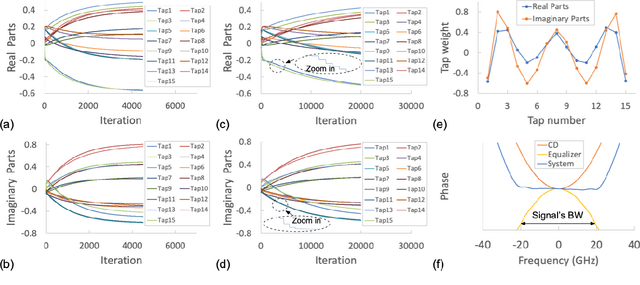

Abstract:We propose a photonic adaptive Least-Mean-Squares equalizer with an opto-electronic feedback loop to determine the updating of an optical Finite-Impulse-Response filter's weights, enabling dispersion compensation introduced by 30-km fiber based on our photonic integrated chip.
Photonic single perceptron at Giga-OP/s speeds with Kerr microcombs for scalable optical neural networks
May 12, 2021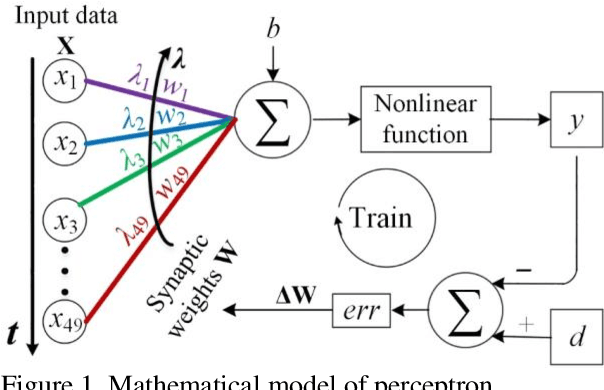
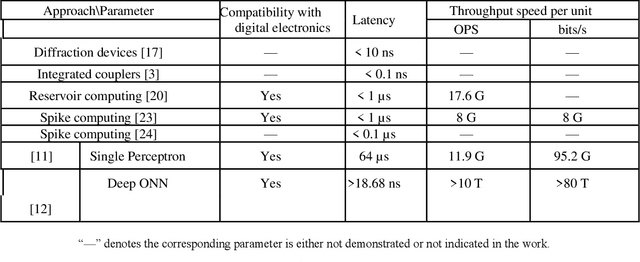
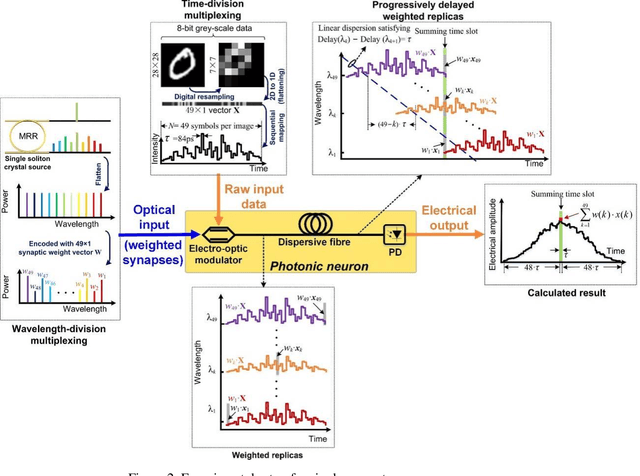
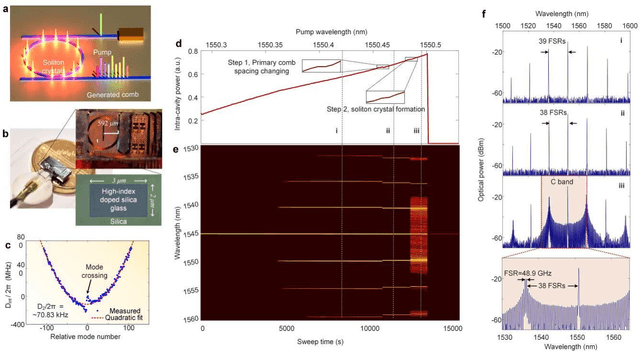
Abstract:Optical artificial neural networks (ONNs) have significant potential for ultra-high computing speed and energy efficiency. We report a novel approach to ONNs that uses integrated Kerr optical microcombs. This approach is programmable and scalable and is capable of reaching ultrahigh speeds. We demonstrate the basic building block ONNs, a single neuron perceptron, by mapping synapses onto 49 wavelengths to achieve an operating speed of 11.9 x 109 operations per second, or GigaOPS, at 8 bits per operation, which equates to 95.2 gigabits/s (Gbps). We test the perceptron on handwritten digit recognition and cancer cell detection, achieving over 90% and 85% accuracy, respectively. By scaling the perceptron to a deep learning network using off the shelf telecom technology we can achieve high throughput operation for matrix multiplication for real-time massive data processing.
* 14 pages, 8 figures, 107 references. arXiv admin note: substantial text overlap with arXiv:2101.12356
11 TeraFLOPs per second photonic convolutional accelerator for deep learning optical neural networks
Nov 14, 2020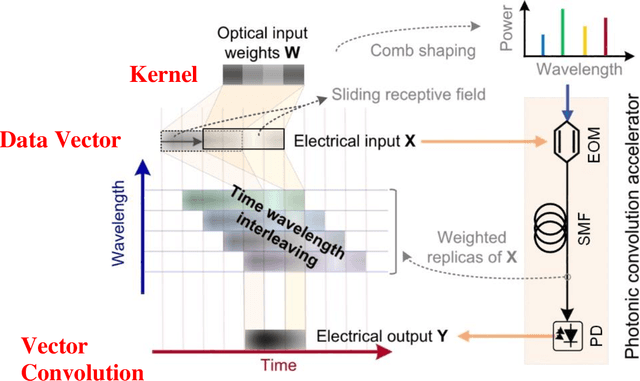
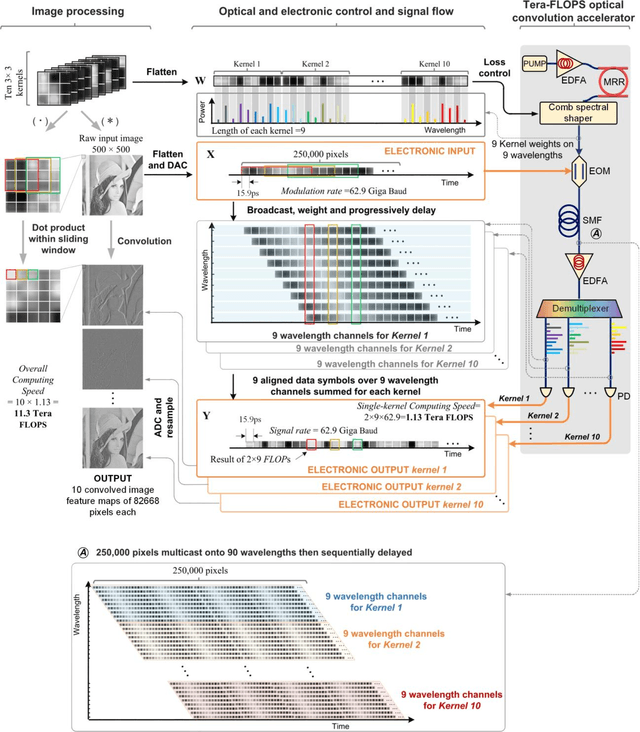
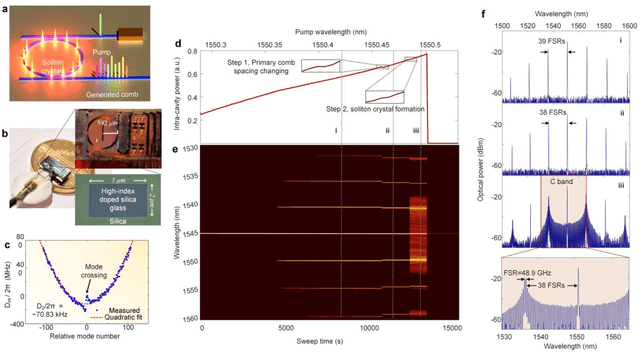
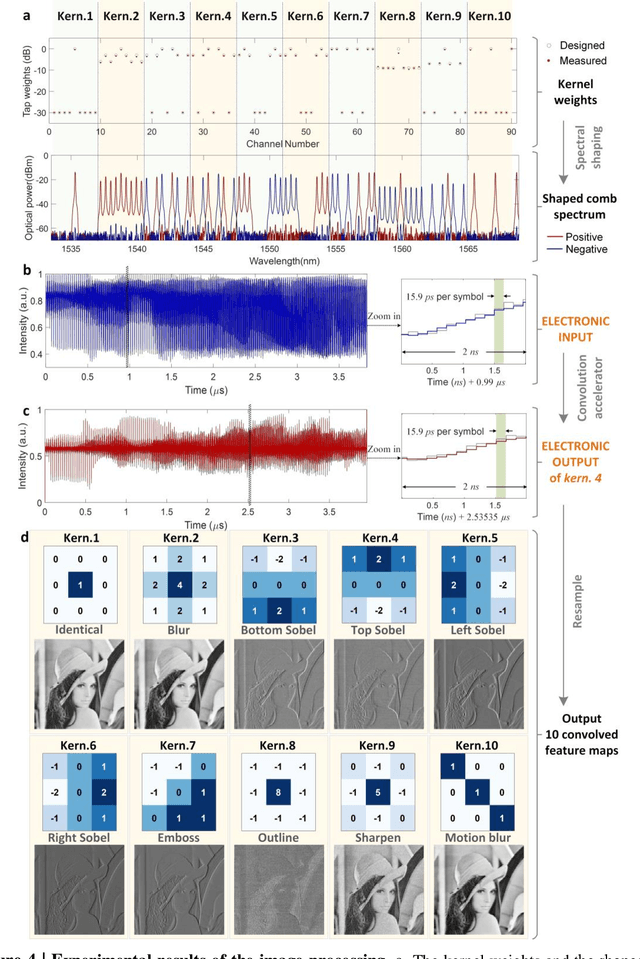
Abstract:Convolutional neural networks (CNNs), inspired by biological visual cortex systems, are a powerful category of artificial neural networks that can extract the hierarchical features of raw data to greatly reduce the network parametric complexity and enhance the predicting accuracy. They are of significant interest for machine learning tasks such as computer vision, speech recognition, playing board games and medical diagnosis. Optical neural networks offer the promise of dramatically accelerating computing speed to overcome the inherent bandwidth bottleneck of electronics. Here, we demonstrate a universal optical vector convolutional accelerator operating beyond 10 TeraFLOPS (floating point operations per second), generating convolutions of images of 250,000 pixels with 8 bit resolution for 10 kernels simultaneously, enough for facial image recognition. We then use the same hardware to sequentially form a deep optical CNN with ten output neurons, achieving successful recognition of full 10 digits with 900 pixel handwritten digit images with 88% accuracy. Our results are based on simultaneously interleaving temporal, wavelength and spatial dimensions enabled by an integrated microcomb source. This approach is scalable and trainable to much more complex networks for demanding applications such as unmanned vehicle and real-time video recognition.
 Add to Chrome
Add to Chrome Add to Firefox
Add to Firefox Add to Edge
Add to Edge